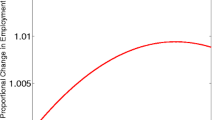Abstract
In this paper the authors put forward their attempt to test a self-employment model using an Italian data set which collects information about 78 Italian provinces (out of 95) over the period of 1985–1988. The self-employment model is introduced as a useful way to explain the formation of new small firms and subsequently previous econometric studies based on this model are discussed and compared.
Once the empirical definitions of the variables are clarified, the econometric specification is introduced in Section 4 and results are discussed in Section 5 and 6.
The general outcome of the estimates backs to a certain extent the self-employment approach which has already been tested with good results both in the U.K. and in the U.S. As far as the income choice is concerned, it turns out to be important in explaining the birth of new small firms. With regard to the role of job-losses, they also turn out to be significantly correlated with the high rates of firm formation.
On the other hand, the discussion reported in Section 5 underlines the importance of other environmental factors which were not included in the original specification of Section 4. In particular, if the numerosity of the existing small firms is taken into account, self-employment relationships lose some of their significance. p]The laborer asks what he thinks the entrepreneur will be able to pay, and in any case will not accept less than he can get from some other entrepreneur, or by turning entrepreneur himself. In the same way the entrepreneur offers to any laborer what he thinks he must in order to secure his services, and in any case not more than he thinks the laborer will actually be worth to him, keeping in mind what he can get by turning laborer himself.
Knight, 1921, p. 273
Similar content being viewed by others
References
Acs, Zoltan J. and David B. Audretsch, 1989a, ‘Small-firm Entry in US Manufacturing’,Economica 56, 255–265.
Acs, Zoltan J. and David B. Audretsch, 1989b, ‘Births and Firm Size’,Southern Economic Journal 56, 467–475.
Baldwin, John R. and Paul K. Gorecki, 1987, ‘Plant Creation Versus Plant Acquisition: The Entry Process in Canadian Manufacturing’,International Journal of Industrial Organization 5, 27–41.
Beesley, M. E. and R. T. Hamilton, 1984, ‘Small Firms' Seedbed Role and the Concept of Turbulence’,The Journal of Industrial Economics 33, 217–231.
Binks, M. and A. Jennings, 1986, ‘Small Firms as a Source of Economic Rejuvenation’, in J. Curran, J. Stanworth, and D. Watkins (eds.),The Survival of the Small Firm, Vol. 1, Aldershot: Gower, 19–37.
Blau, David M., 1987, ‘A Time Series Analysis of Self-Employment in the United States’,Journal of Political Economy 95, 445–467.
Creedy, J. and Peter S. Johnson, 1983, ‘Firm Formation in Manufacturing Industry’,Applied Economics 15, 177–185.
De Wit, Gerrit and Frans van Winden, 1991, ‘An M-Sector, N-Group Behavioral Model of Self-Employment’,Small Business Economics 3, 49–66.
Evans, David S. and Linda S. Leighton, 1990, ‘Small Business Formation by Unemployed and Employed Workers’,Small Business Economics 2, 319–330.
Garofoli, Gioacchino, 1990, ‘New Firm Formation and Local Development: the Italian Experience’, paper presented at theRSA European Congress, Istambul, August 28–31.
Geroski, Paul and Schwalbach, Joachim (eds.) (1991),Entry and Market Contestability: An International Comparison, Oxford: Basil Blackwell.
Hamilton, R. T., 1989, ‘Unemployment and Business Formation Rates: Reconciling Time-series and Cross-section Evidence’,Environment and Planning 21, 249–255.
Highfield, Richard and Robert Smiley, 1987, ‘New Business Starts and Economic Activity: An Empirical Investigation’,International Journal of Industrial Organization 5, 51–66.
Hudson, John, 1987, ‘Company Births in Britain and the Institutional Environment’,International Small Business Journal 6(1), 57–69.
Hudson, John, 1989, ‘The Birth and Death of Firms’,Quarterly Review of Economics and Business 29(2), 68–86.
Johnson, Peter S., 1986,New Firms: An Economic Perspective, London: Allen and Unwin.
Johnson, Peter S., 1988, ‘A Note on the Modelling of the Formation Decision: Two Studies Compared’,Scottish Journal of Political Economy 35, 176–180.
Khemani, R. S. and D. M. Shapiro, 1986, ‘The Determinants of New Plant Entry in Canada’,Applied Economics 18, 1243–1257.
Kihlstrom, Richard E. and Jean-Jacques Laffont, 1979, ‘A General Equilibrium Entrepreneurial Theory of Firm Formation Based on Risk Aversion’,Journal of Political Economy 87, 719–748.
Knight, Frank H. 1921,Risk, Uncertainty and Profit, Boston: Houghton Mifflin.
Lucas, Robert E., 1978, ‘On the Size Distribution of Business Firms’,The Bell Journal of Economics 9, 508–523.
Maddala, G. S., 1987,Econometrics, Singapore: McGraw-Hill.
Mansfield, Edwin, 1962, ‘Entry, Gibrat's Law, Innovation and the Growth of Firms’,American Economic Review 52, 1023–1051.
Orr, Dale, 1974, ‘The Determinants of Entry: a Study of the Canadian Manufacturing Industries’,Review of Economics and Statistics 56, 58–65.
Oxenfeldt, A. R., 1943,New Firms and Free Enterprise: Pre-War and Post-War Aspects, Washington: American Council on Public Affairs.
Rees, Hedley and Anup Shah, 1986, ‘An Empirical Analysis of Self-Employment in the U.K.’Journal of Applied Econometrics 1, 95–108.
Storey, David J., 1982,Entrepreneurship and the New Firm, London: Croom Helm.
Storey, David J., 1991, ‘The Birth of New Firms — Does Unemployment Matter? A Review of the Evidence’,small Business Economics 3, 167–178.
Storey, David J. and A. M. Jones, 1987, ‘New Firm Formation — A Labour Market Approach to Industrial Entry’,Scottish Journal of Political Economy 34, 37–51.
Vivarelli, Marco, 1991, ‘The Birth of New Enterprises’,Small Business Economics 3, 215–223.
Author information
Authors and Affiliations
Rights and permissions
About this article
Cite this article
Foti, A., Vivarelli, M. An econometric test of the self-employment model: The case of Italy. Small Bus Econ 6, 81–93 (1994). https://doi.org/10.1007/BF01065181
Received:
Issue Date:
DOI: https://doi.org/10.1007/BF01065181




